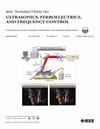Solidly Mounted Scandium Aluminum Nitride on Acoustic Bragg Reflector Platforms at 14–20 GHz
IF 3.7
2区 工程技术
Q1 ACOUSTICS
IEEE transactions on ultrasonics, ferroelectrics, and frequency control
Pub Date : 2025-03-25
DOI:10.1109/TUFFC.2025.3554597
引用次数: 0
Abstract
This article reports the first groups of low-loss acoustic solidly mounted resonators (SMRs) and acoustic delay lines (ADLs) at 14–20 GHz. Bulk acoustic waves (BAWs) are confined in thin-film scandium aluminum nitride (ScAlN) on top of dielectric acoustic Bragg reflectors, consisting of alternating silicon dioxide with tantalum pentoxide (Ta2O5/SiO14-20 GHz声学Bragg反射平台固载氮化钪铝。
本文报道了第一批14-20 GHz低损耗实装声学谐振器(SMR)和声学延迟线(ADL)。体声波(BAW)被限制在介质声Bragg反射器顶部的薄膜氮化钪铝(ScAlN)中,由硅载体晶片上的二氧化硅与五氧化二钽(Ta2O5/SiO2)或五氧化二铌(Nb2O5/SiO2)交替组成。通过高分辨率x射线衍射(HRXRD)和x射线反射率(XRR)提取堆叠材料参数。仿真和实验结果表明,在14 ~ 20 GHz范围内对纵向BAW有约束。Ta2O5/SiO2和Nb2O5/SiO2的adl具有较高的传播Q值,分别为478和171。在18.6 GHz下,Ta2O5/SiO2的耦合系数(k2)为2.0%,串联Q (Qs)为156,并联Q (Qp)为140,Nb2O5/SiO2的耦合系数(k2)为2.4%,Q (Q)为140,Qp为109。在开发过程中,ScAlN稳固安装平台将使信号处理元件具有更好的功率处理能力。
本文章由计算机程序翻译,如有差异,请以英文原文为准。
求助全文
约1分钟内获得全文
求助全文
来源期刊
CiteScore
7.70
自引率
16.70%
发文量
583
审稿时长
4.5 months
期刊介绍:
IEEE Transactions on Ultrasonics, Ferroelectrics and Frequency Control includes the theory, technology, materials, and applications relating to: (1) the generation, transmission, and detection of ultrasonic waves and related phenomena; (2) medical ultrasound, including hyperthermia, bioeffects, tissue characterization and imaging; (3) ferroelectric, piezoelectric, and piezomagnetic materials, including crystals, polycrystalline solids, films, polymers, and composites; (4) frequency control, timing and time distribution, including crystal oscillators and other means of classical frequency control, and atomic, molecular and laser frequency control standards. Areas of interest range from fundamental studies to the design and/or applications of devices and systems.

 求助内容:
求助内容: 应助结果提醒方式:
应助结果提醒方式:


